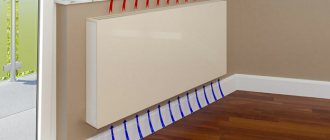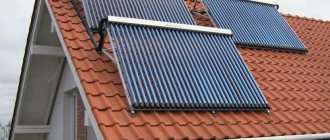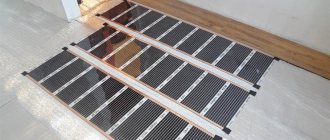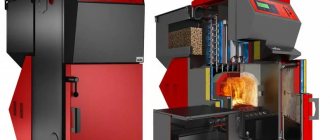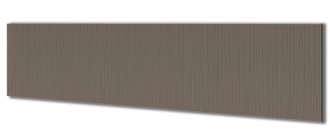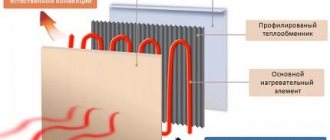Options for using technology
Infrared heating is used quite widely today.
Regardless of whether a person lives in the house permanently or uses the home as a temporary shelter, such devices are ideal for heating living rooms at any time of the year. But this is not the only area of their application. Such units can be used for heating balconies and loggias, unheated garages, dressing rooms, terraces, verandas of open and closed gazebos, greenhouses and winter gardens, chicken coops and other premises for animals.
With the help of such devices, you can very quickly reach the desired room temperature, warm the soil, extend the summer season, reap a good harvest, and achieve amazing results in livestock farming. At the same time, creating a comfortable microclimate will not provoke an increase in electricity costs, which leads to significant financial savings.
Features of the film heater
Infrared film wall heaters are quite popular. They consist of a resistive-type heating element, a heat-distributing base, a thermostat, two protective layers and a connection cable. The total thickness of the sheet is no more than 1.5 mm.
The thermostat has a temperature sensor, which simplifies operation. The laminating film used in this work can withstand temperatures up to 210˚C. Such layers are used as protective layers; between them there is foil with heating elements. This infrared flexible film wall heater has resistors, and the heating elements are based on metals or carbon-containing materials. When an electric current passes through them, heating occurs up to a maximum of 55 ˚C.
Notes and recommendations for use
Tips for using and storing infrared film:
- There is no point in relying on an effective heating system with infrared film in the absence of an outer layer of thermal insulation of housing;
- the material must be stored in a dry place;
- when using the wall-mounted version, it is necessary to exclude mechanical impact on the device;
- It is forbidden to turn on the film when rolled up, otherwise the unit will overheat and catch fire;
- the aggregate cannot consist of waves of the same length;
- the film heating element does not burn oxygen, there is no need to ventilate the room often;
- It is not necessary to turn off the heating in the summer. It is enough to set the thermostat, the system will control the parameters;
- the declared service life of the film material is 50 years, however, the heating film appeared recently;
- film is an electrical device. Safety precautions must be observed.
Infrared film material is used for heating a room on the floor, ceiling, and walls.
Positive and negative properties of the IR heater:
Average score of ratings is more than 0
Share link
Comments There are no comments yet, but you could be the first...
Main types of infrared heaters
Infrared heaters for the home are presented on the product market in a variety of types and characteristics.
Classification of devices
Heaters are distinguished by the following features:
- By type of placement. Ceiling, wall, floor and film are available. The first two types of placement involve stationary use. They are mounted using brackets or hooks, respectively, on the ceiling or wall. Since the design is lightweight, there are no special requirements for fasteners. Floor-standing devices have a special stand in their design, on which they are installed anywhere on the floor. A special type is film devices. The heating element here is a flexible resist cable that heats the outer metal film.
- By radiation power. Infrared heaters for home are manufactured with a power from 200 W to 2.5 kW, and those intended for use in industrial areas - over 2 kW.
- According to the range of waves used. Waves lying in the range from 5.6 to 100 microns are called long-wavelength. They have an operating temperature of about 600 degrees and are completely harmless to the human body. The range from 2.5 to 5.6 microns is called mid-wave, the heating temperature can be 1 thousand degrees. Such devices are used in rooms with high ceilings. Short-wave, using a wavelength of up to 2.5 microns, are considered harmful to the human body, and are used for ceiling mounting at a height of 5-7 meters.
- Based on the type of heating element used, heaters are structurally divided into lamp, panel, and film. Lamp ones are made with a tubular heating element. They differ in shape, flask filling (vacuum or gas), and spiral material. Typically, in addition to the lamp, the device includes a reflector and a protective transparent screen. Panel heaters are produced in the form of flat panels of various sizes. The heater itself is made of quartz or carbonite.
- Depending on the method of powering, devices can be electric, gas or diesel.
Halogen lamps are low cost, but when they work, heating light is visible. While quartz and carbon, although more expensive, work in the invisible spectrum for the human eye.
Micathermic heater
This device is a new technological solution on the IR heaters market. The radiation source in the device is the plate. This plate is made of several layers of mica, due to which thermal radiation spreads evenly and heating occurs very quickly. It must contain protection against overheating and overturning of the device.
The main advantages are efficiency, since energy costs are lower by almost 30 percent compared to other types of IR heaters. The case temperature does not exceed 50 degrees, complete silence. Different body variations make this product even more attractive. Greater degree of mobility. The main manufacturer is Polaris. The disadvantage of such a heater is its price.
Ceiling infrared heating
Under ceiling infrared heaters goes from? before ? ceiling area. The remaining space is enough to accommodate lighting fixtures and communications. Decorative finishing material, plasterboard panels, suspended ceilings, etc. do not interfere with functioning and do not deteriorate themselves.
Diagram of an IR heating film device
- Stage 1. Installation of a heat-reflecting screen
- Initially, a foil heat-reflecting screen (folgoizol, penofol, etc.) is installed on the entire ceiling surface of the room. This achieves an almost twofold increase in the downward heat flow. If thermal insulation is insufficient, it is better to use insulation with a thickness of 10 mm, otherwise insulation with a thickness of 5 mm is sufficient.
- Fastening to a wooden surface is done with metal staples or a regular furniture stapler.
- Fasteners are placed on the concrete floor in increments of 0.5 meters. Most often this is a wooden sheathing. The strips are attached with an overlap of 2-3 cm, followed by gluing the joints with foil tape.
Advice: whether you work alone or with an assistant, it is easier to use a 60 cm wide roll of thermal insulation and film material: it is easier to hold and there are fewer mistakes.
- Stage 2. Installation of film heaters.
- A pre-calculated number of heating elements is attached similarly to heat-reflecting material. It is only necessary to install brackets or other fastening elements in specially designated places so that the infrared film for the ceiling is not damaged at other points.
- Stage 3. Electrical installation.
Connecting individual elements
- The wire cross-section is selected according to the total power of the connected heaters.
- All wires are hidden in the cable channel.
- Thermostats are installed in each room at a height of 1.1 - 1.4 m. For a small heated area, up to 5 m2, they are connected “into the break” of the line.
- A larger area requires a high-power heater, and the thermostat is connected exclusively through a magnetic contactor.
- The lines, hidden in the corrugation, pass to the distribution board, in which the power and control wires are connected to the circuit breakers and magnetic contactors.
- The first testing of the system is carried out after connecting the common “Input”.
Installation of heating panels
The total load power is calculated, wires and boxes are selected. After this, a panel with differential automatic machines is installed. There are as many differential circuit breakers installed in the panel as there are rooms planned to be connected. Wiring is laid from the shield.
Ceiling infrared panels can be installed independently. Installation of infrared ceiling heating panels follows the procedure for installing fluorescent lamps.
Calculation of infrared heating power
It is not difficult to independently calculate the required equipment. For a 10 m2 area with ceilings of 2.5-3 m, a house with good thermal insulation requires infrared ceiling heaters with a power of 1 kW. More rigorous figures can be obtained using data from a specific device. Of course, we are not talking about constant electricity consumption: during operation, the equipment, maintaining a given mode, works for approximately 20 minutes out of every hour. Effective power consumption for a house with an area of 55 m2 is about 2 kW, which is quite a bit!
Advantages and disadvantages
The main advantage of such equipment is high efficiency. A person, like an object, heats up under the influence of infrared radiation. Almost immediately after turning on the device in the room, a person begins to feel warmth.
In addition, among the advantages of IR heaters are:
- High efficiency. The effectiveness of such heating lies in the direct thermal effect on the object without loss of power for heating the air environment.
- Cost-effectiveness, which is ensured by a long period of heat transfer from heated objects and the absence of dependence on air flows (drafts).
- Versatility. IR emitters can be used both indoors and outdoors. The owner can independently adjust the power and radiation angle.
- Easy to install and operate.
In addition, IR heaters do not dry out the air, which is very important for maintaining a healthy indoor microclimate. Despite the abundance of advantages, IR heaters also have disadvantages, namely:
- As soon as a person leaves the radiation zone, he immediately begins to feel a temperature difference.
- Dimensions that directly depend on the power of the device.
- Fire hazard if the emitter is not focused correctly.
The issue of the safety of long-term human exposure to infrared radiation is being actively discussed online. Doctors and physicists have not been able to reach consensus on this issue, so the lack of confidence in the safety of these devices for humans should also be considered a disadvantage.
Installation of film-type IR heaters
Installation of flexible film heaters, regardless of the installation location, does not require the contractor to have high-level professional skills, but must be carried out in compliance with the following rules:
- the installation site of the PLEN must be level and dry;
- cutting rolls, if provided for by the model, should be performed only according to the markings specified by the manufacturer;
- testing the functionality by plugging in a rolled-up heater is prohibited;
- the length of one strip film fragment should not exceed 8 m;
- adjacent strips of the heating system are located at a distance of at least 5 mm;
- bending the PLEN at an angle of more than 90 degrees is not allowed;
- installation of the film to the base is carried out with staples using a construction stapler or special fasteners (the use of ordinary nails and self-tapping screws is not effective);
- It is prohibited to carry out installation work at sub-zero air temperatures - after warming up the room, the film strips will increase in size and form folds.
Sequence of installation of film IR heaters
To protect against overheating, the base for placing the PLEN must be equipped with a foil reflective screen that acts as a heat and water insulator, for example, penofol, isolon.
The protective coating is mounted on the base with an overlap of adjacent edges of 3-5 cm; to speed up the process, it is advisable to use special fasteners for fastening, which are available in a wide range on sale.
From above, the joints of the screen strips are glued longitudinally with special foil tape.
The elements of the film heater are mounted on top of the laid screen - after preliminary layout and in accordance with the installation instructions supplied with the device. Installation is carried out taking into account the rule - for 1 square meter of flexible film there should be 8-10 fastening elements.
When the heating circuit is ready to be installed, it is connected to the thermostat, which should be located at a height of 1-1.5 m from the floor, and the system’s functionality is checked.
In addition, to correctly monitor the temperature in the room, the thermostat must be located away from other heating devices, have a thermal insulation pad underneath, and be protected from direct sunlight and drafts.
If the results of testing the IR device are positive, finishing materials are laid - floor covering or suspended ceiling, which are installed with a gap of 10-15 mm between the cladding and the film.
Read on the topic - how to attach, lay and glue penofol.
Installation sequence of IR heaters
The installation of infrared heating consists of three processes:
- At the initial stage, foil material is laid, which performs the functions of insulation and waterproofing. Typically, folgoizol or penofol or their analogues are used for this. The main requirement is installation on a flat base. The result should be a reflective screen.
- At the next stage, they begin to lay out the heating elements. It is imperative that the busbars of connecting sections be insulated. After this, the heating film is attached to the base.
- At the end of the installation, electrical measures are performed. It is necessary to connect a thermostat through which the cable is laid to connect to the AC mains. It is advisable to hide the wiring under the baseboards or lay it in specially equipped installation channels.
After completing the installation of infrared heaters, you should check the operation of the heating system. If the installation is completed correctly, proceed to laying the flooring or finishing the ceiling. It is also worth considering other types of infrared heaters that differ from film heaters.
Despite the increasing popularity of infrared heating of premises for various purposes, film-type heating equipment is not in sufficient demand, despite its excellent technical and operational performance. Typically, this type of heating system is used as an additional source of thermal energy.
Criterias of choice
To purchase a high-quality unit suitable for a particular home, you need to pay attention to the technical characteristics, as well as the efficiency of the equipment. You can also look at a number of additional functions and the cost of the device
As for the cost, you can choose high-quality models at approximately the same price, which greatly simplifies the choice. If desired, you can find more expensive types of devices equipped with additional functionality.
You need to know that convection and ceramic heaters become ineffective if the house has very high ceilings
This is also worth paying attention to when purchasing.
If the heater needs to be used constantly, then you will need to choose the most powerful models that have a heat sensor, timer, and other useful functions. In this way, system efficiency can be increased and energy consumption can be reduced. But you will have to spend an extra few thousand rubles on such models.
Also, before purchasing, it is advisable to read the reviews of people who have already purchased the equipment and installed it in their home. If a certain model or company has a large number of positive reviews, then this is considered one of the main guidelines when choosing the right unit.
Operating principle of infrared heaters
At their core, infrared electric heaters are a heated physical body that emits infrared waves. A feature of this radiation spectrum is the ability to transfer thermal energy, which is absorbed by nearby objects. As a result, uniform heat transfer occurs, which makes the temperature in the room more comfortable.
This heating method is good because it allows you to make the temperature at different altitudes of the room the same; there is no overheating of the upper part of the room, as happens when using traditional heating devices.
Main types of infrared heaters
Manufacturers offer various devices that operate on the principle of infrared emitters. They all have their pros and cons and can be used for heating premises in various conditions.
Most often used:
- Wall heaters, which can have different designs, differ in power consumption. This type of device is used most often.
- Floor heaters are arranged in a layer under the covering used. They are distinguished by high power and are able to create quite comfortable conditions. The cost of such systems is quite high.
- Window heaters, they are also called moldings. They have small overall dimensions and are installed above window openings. Devices of this type can effectively combat cold drafts typical of rooms with low-quality windows.
Operating principle of infrared heaters
Advantages of wall-mounted infrared heaters
Wall-mounted heater models are becoming the most popular. In many ways, the demand for them is determined by interesting design solutions. Some modifications are almost impossible to distinguish from wall paintings or other decorative elements.
But besides their appearance, infrared wall heaters deserve attention due to their other features:
- The high efficiency of infrared heaters ensures their low power consumption. The use of such devices is more advantageous compared to other electrical devices.
- An infrared heater does not burn out oxygen, making the entire atmosphere in the room more favorable for humans.
- An infrared heater with a thermostat allows you to maintain the optimal temperature within a given range.
- Devices of this type meet safety requirements; the heating temperature of the working surface in rare models exceeds 70 degrees.
The main types of wall-mounted infrared heaters
On sale you can most often find two main types of wall-mounted heaters.
- The first panels to appear on the market were only a few centimeters thick. Various types of temperature-resistant plastic, glass and some other substances can be used as the housing material. The power of the heating element used in the design of such a wall-mounted infrared heater is quite high; it can be used to heat even a large room. These devices are reliable, economical and durable.
- Recently, ultra-thin infrared film-type heaters have become increasingly popular. Such devices can be placed on any wall surfaces; they are absolutely safe.
Film wall infrared heater
Structurally, these heaters are a two-layer film structure, inside of which a heating element made of carbon filament is placed. Such a thread receives thermal energy, the parameters of which are close to ordinary solar heat. Thanks to this, such heaters allow you to create the most comfortable indoor conditions for a person.
A standard film heater has dimensions of 1 by 0.6 meters; manufacturers offer devices with different designs that can fit into any interior.
A distinctive feature of infrared devices is their noiselessness during operation, so they can be used even in children's and bedrooms.
Principle of operation
Each infrared film heater operates on the principle of transferring thermal energy to nearby objects, which then release it into the surrounding space. This type of radiation does not warm up the air. These rays are capable of warming extremely dense materials, which give off heat to the air inside the premises.
This heating method provides conditions for the uniform distribution of warm air masses, as well as for the rational use of electric current and increasing the efficiency of the heating system as a whole.
Resistive heating film elements that make up infrared systems are mounted on foil. They are protected on both sides by a laminated film. The result is a thin structure, the thickness of which does not exceed 1.5 millimeters.
The finished film mats are laid parallel to each other. They are selected so that they cover the entire area of the heated floor covering. The mats are connected to the power supply according to a parallel circuit - each separately. Thanks to this installation method, the system will be able to function even when one of the elements fails.
The operation of the film heater is controlled using a temperature sensor. When power is supplied to the system, it begins to heat up, and IR rays with a length of 10–15 microns are released. Once the desired temperature is reached, the electricity supply is turned off. If the temperature decreases, which is detected by the temperature sensor, the power turns on, on the contrary.
Operating principle of PLEN
When the power cable is connected to the network, the resistive elements heat up to a preset temperature value (35-50 degrees) within 10 seconds. Film heaters for non-domestic purposes (for mini-saunas, dryers of agricultural products), used in rooms with ceiling heights of more than 3.5 m, have resistive elements of wire, tape, plate design made of nichrome, fechral or multicomponent alloys, providing a higher temperature heating
The heat of the heaters is transferred to the foil and, due to the high thermal conductivity of aluminum, is evenly distributed over its surface, which allows the heater to generate IR radiation of equal intensity over its entire area. When the air in the room reaches the set temperature value, the film heater turns off based on a signal from the temperature sensor in the thermostat, and objects heated by radiation continue to give off heat. When the temperature in the room drops by 1 degree, the thermostat will turn on again, and the film heater will perform a new radiation cycle.
A correctly calculated combination of the material of the reflective layer, its thickness, and the arrangement of resistive heaters ensures the conversion of electricity into heat, and then into infrared radiation with a wavelength of 8-15 microns favorable for human perception.
Flexible tape heater ENGL-1
This tape is based on eight strands of nichrome wire, they are coated with silicone rubber, the outer shell is made of fiberglass for better thermal conductivity. Silicone rubber provides good flexibility and moisture insulation.
Tape heater ENGL-1
The heater has a calculated length and a sealed tip; cutting it into pieces is prohibited. Manufacturers, at the request of the customer, produce tapes of various lengths and power consumption, but not more than 100 W per 1 m. It is very simple to install and connect, no special training is required.
Main technical characteristics:
- power supply from 220V network;
- width – 24 mm;
- thickness – 3 mm;
- operating temperature on the surface of the outer shell is 180-250 °C.
The tape is recommended to be used for heating elements on production lines and heating roofing coverings.
Description
Infrared electric heaters become in demand at a time when it is already cold outside and the central heating has not yet been connected. If you find yourself in such a situation, you can resolve the issue in one of two ways. The first involves the use of a different type of heater, while the second involves the use of infrared devices. Such devices produce thermal energy that passes through the air and heats objects. It is the surfaces that begin to heat up, due to this the room becomes warm. The degree of heating will depend on the shape of the surface, the angle of incidence of the rays, and the materials. Heat is transferred into the air from the objects themselves, and not from the heating device. Infrared electric heaters operate on a principle that involves accumulating heat in the place where it is most needed, namely, near furniture, walls and people in the room. An interesting fact is that the heat released from the heater can be compared to natural solar radiation.
Q-TERM 0.5 m 220 W
Infrared film 0.33 mm thick. Packaging: roll. Device power – 220 W. Width – 50 cm, supplied in pieces, from 1 linear. m.
It is used as the main or additional source of heating (warm floor system) in an apartment or country house.
Advantages:
- easy to install;
- no screed needed;
- heats up quickly (in 20-30 seconds).
Flaws:
- not identified.
Purpose
The main purpose of an infrared heater is to expose any absorbing surface to the rays it produces. Such surfaces include any objects around you that absorb light energy, that is, not transparent and the person himself. Due to this property, heating of the surrounding air space is a side effect of the operation of an infrared heater, when thermal energy from heated objects is transferred to the air. This determines the main advantage over classical systems - direct impact on a specific area and the absence of such large losses.
Rice. 1: fundamental difference in heating
In practice, an infrared gas heater is designed to heat any space in places where it is not possible to connect electric convectors to the network or where power supply is impractical.
As specific examples, an IR heater can be used for:
- Heating of gazebos and tables in nature, in park areas and recreation areas, etc.;
- Heating tents in the cold season from a gas cylinder;
- Heating garages to ensure comfortable working conditions;
- Heating of residential premises in summer cottages;
- Ensuring temperature conditions in the working area of industrial premises;
- Heating of greenhouses, chicken coops and nurseries for livestock;
- Heating any area in the open air (at construction sites, quarries, geological exploration sites, terraces, etc.).
Also, using this type of gas heaters, various surfaces can be dried and heated. An important advantage of an infrared gas heater is the use of a special element for burning fuel and producing infrared radiation. This feature makes its operation identical to that of electrical appliances, with the difference that it can function regardless of the presence of a centralized fuel source.
Classification according to the method of arrangement of elements
Infrared heating devices are presented on the market in a wide range. According to the method of arrangement of heating elements, they can be divided into three groups: floor, wall and ceiling.
Option #1 - floor heaters
Floor coverings are modular materials, inside of which flat heating elements are laid. The coating is produced in the form of rolls. For installation, it is cut into pieces of the required sizes.
Strips of rolled material are placed on the floor so that the emitters do not end up under heavy furniture; this will prevent a decrease in heat transfer and drying out of the wooden elements of the set
The insulating material and infrared film are laid directly on the prepared base floor. During the installation process, avoid placing the panels overlapping and try to maintain a distance of 10-15 cm from the walls.
The following can be laid on top of floor infrared strips:
- carpet;
- parquet board;
- linoleum;
- laminate;
- ceramic tiles.
The most successful combination is obtained when using ceramic tiles as a floor covering. Laminate is a little inferior in this regard. And the greatest shielding of IR radiation is created by carpet and linoleum.
Film systems are installed not only on floors, but also on ceilings under suspended structures and attic roof slopes. Installation and connection are carried out according to a similar scheme:
Image gallery
Photo from
Preparing IR film for installation on the ceiling
Film heating construction process
Preparing the heating system for finishing
Connection to control unit
Infrared heating systems include not only film options, but also rod carbon floors. A popular article on our website will introduce you to the rules for installing them.
Option #2 - wall and ceiling fixtures
Compared to underfloor heating systems, the choice of ceiling and wall-mounted units is wider. In addition to traditional panels, there are also designer built-in models of ceiling radiators.
They can be installed in suspended ceilings. They are available for sale in different sizes and colors.
The plates are placed in such a way that the rays emanating from them are directed to the furniture, and the latter, having absorbed heat, begins to act as a source of thermal energy
Ceiling models of infrared emitters are located at a height of 3 meters and above. With this arrangement, the thermal ceiling is directed downward and diverges slightly to the sides.
Rushing down, the rays first warm up the floor covering. Due to this, the temperature at the level of the feet is always a couple of degrees higher than in the head area. To prevent heat from leaking into the street, the panels are not placed opposite doors and window openings.
Wall-mounted infrared emitters are placed so that they are above or below the level of a person’s head
Among wall emitters, it is worth highlighting baseboard systems. They are narrow, long structures. The systems are installed around the perimeter of the room, placing them instead of conventional plastic or wooden baseboards.
When choosing a location for placing panels, you should avoid recreation areas where there is a high probability of direct impact on household members. For example: at the level of a sofa or bed.
Otherwise, the rays directed at right angles will overheat and dry out the skin, causing discomfort among residents and guests of the house. The coverage area of directional emitters is one of the main characteristics and is usually indicated in the product data sheet.
IR wall heaters are rarely used. The circulation of warm and cold air occurs from bottom to top, so it is wiser to prefer ceiling or floor options
Types of infrared heaters
The principle of infrared electric heaters is that the devices emit long wavelengths. They are perceived by the skin as heat that comes from the sun's rays. If we consider the types of such devices, we can distinguish wall, ceiling or floor models. Which device to choose will depend on the size of the room and the intended conditions for using the device. A stationary device will not be able to be moved from room to room, but mobile heaters, as a rule, are smaller in size and have low power. If you decide to choose a stationary unit, you can choose a baseboard, ceiling or wall unit. According to the majority, ceiling-type devices are the most convenient. They take up the least space, and their radiation range is very large.
On sale you can find models that are mounted in a suspended ceiling or built into it. You can choose an option that is attached to the surface using hanging brackets. In this case, the step to the base of the housing from the ceiling surface should not be less than 5 centimeters
It is important to remember that when choosing floor-mounted low-power heaters, you run the risk that the radiation will encounter many obstacles along its path. It is best to choose such devices with tubular or carbon heating elements
Versatility, health benefits, safety
Nobody bothers you to combine infrared heating batteries with conventional radiators - they can complement each other. With minimal effort, you can create a “warm island” in your home by installing 2-3 simple heaters, which will be directed to the kitchen corner, for example, or to the sofa. They are often installed in gazebos on the streets or in verandas. This will allow you to sit outdoors even in relatively cold weather.
Installation of infrared heaters is extremely simple - they can be placed on a special leg, hung on a wall or attached to the ceiling. They plug into an outlet and are immediately ready to use.
It is believed that infrared heating systems are more beneficial for human health. The sun's rays, when they hit a person's skin, penetrate inside and heat the blood vessels, causing heat to quickly spread throughout the body. However, there are often disputes that infrared heaters are harmful to health, which is not true. According to research by Japanese scientists, these devices serve as a preventive measure against many diseases.
Advantages and disadvantages
Advantages of wall-mounted devices:
- Modern home heating devices are characterized by low energy consumption, but at the same time they are highly efficient.
- Using equipment, you can convert electricity into heat by 90% or a little less.
- In earlier times, floor heaters were often used, which took up quite a lot of space and were very heavy. The use of devices indoors spoiled the appearance and also made it impossible to use 100% of the entire space of the room. But the days of large-sized structures are over, and on sale you can find convenient and small wall-mounted analogues that have great practicality, aesthetic appearance, and practicality.
- There are a large number of models from different manufacturers to choose from. Therefore, the choice is quite wide and it is possible to choose the ideal option that suits a specific situation, as well as depending on a person’s financial capabilities.
- There is a wide color palette of devices, as well as various decorative solutions for the body. The heater also serves as a decorative element if you purchase a housing with an interesting design.
Flaws:
- Some models may dry out the air a little during operation.
- You will have to comply with the mandatory conditions during installation - select a certain distance between the floor and the unit.
- If a person has never worked with a drill and brackets, he will have to call a specialist to install the equipment.
Additional functions and equipment
Modern infrared heaters can be equipped with additional options that simplify the operation of the device, but significantly increase its cost. In modern heating devices you can find:
- Built-in humidifier that helps create an optimal and healthy microclimate in a heated room.
- The fan creates air currents to distribute heat evenly throughout the room.
- The disinfectant neutralizes most pathogenic bacteria in the air.
- The ionizer reduces the amount of dust in the air.
- The built-in thermostat is designed to regulate and maintain the set temperature.
- Automatic shut-off device in case of accidental fall. Very desirable for floor models.
- A telescopic tripod allows you to change the position of the emitter in space.
- Remote control. Availability will be a plus.
- A protective grille is required for all mobile and some wall-mounted models.
- The swivel bracket is required for wall-mounted models.
- Overheating protection is required.
- Moisture protection. A necessary option if you plan to use the device in wet areas.
Rules for installing infrared wall heaters
To ensure safe operation and longevity of such heaters, the following installation recommendations should be followed:
- Wall mounting should only be carried out using the elements included in the delivery kit. Replacement and use of other fasteners is not permitted.
- The distance from the heater to the nearest objects on all sides must be at least 100 mm to ensure free air circulation.
- It is not recommended to install heaters of this type in small enclosed spaces. In addition, it is prohibited to cover infrared heaters with fabric or other materials.
Film heaters of the Technology 21 brand
Heaters of domestic development have a very affordable price.
On average, such a device can be purchased for 1300-1500 rubles.
Film infrared wall heater Sunbeam “CITY”
Made in the form of a color painting, it can fit into any interior. Has the following characteristics:
- Power consumption - 400 W.
- The maximum surface temperature does not exceed 75 degrees.
- Reaches operating temperature in just 1 minute and can be used for long periods of time. Allows you to heat objects located at a distance of up to 6 meters.
- It features reliable protection and can be used in rooms with high humidity.
- Has a significant working resource.
Wall heaters Teplofon
The products of this company are also quite affordable.
So, model ERGNA 0.3/220(p)
Heater Teplofon ERGNA 0.3
power 300 W
The temperature of the working surface does not exceed 90 degrees, so special attention must be paid to maintaining regulatory clearances to nearby surfaces
It will cost only 1750-1900 rubles.
The installation can be used to heat a room whose area is 12-15 square meters.
Therefore, it is worth considering the possibility of using them, at least as auxiliary devices that can ensure the creation of comfortable conditions in case of problems in the operation of central heating systems.
We also recommend watching:
- How to choose a geyser - overview of manufacturers and models
- The principle of heating control via a GSM node
- Combined indirect heating water heater
- Installation rules and choosing the best heating meter for an apartment
Properties
The heater is produced in the form of a film material, available in rolls. Covering: plastic film. Thanks to the carbon ball and copper tires, heat transfer is 100%. The film heater can be designed as an additional, main heating system. The film is mounted on walls, ceilings, or hung on walls in the form of paintings or panels.
Used for heating production and storage areas, garages, sports grounds, baths.
Characteristics of film heater
Installation of infrared heaters
Many people nowadays are concerned about choosing a place to install an infrared heater. On average, this device has a length of about 80 cm, which is quite a lot. Today, manufacturers can provide floor, wall, and ceiling devices. It is the latter option that is in greatest demand. When installing the device on the ceiling, you can significantly save space in the room. Additionally, the air will warm up better. However, such infrared heaters also have disadvantages. First of all, they are associated with poor fastening and the inability to install with low ceilings.
Wall-mounted devices also have their fans. The main thing is to choose a suitable place. There should be no fire hazardous materials nearby (including on the wall itself). Furniture, in turn, must be placed at a safe distance. The damage to an infrared heater if installed incorrectly can be significant.
The last type of installation is called floor-mounted. It is the most common because it is the simplest. An infrared heater usually comes with a tripod or a small stand. With its help you can easily adjust the height of the device. You can also quickly move the infrared heater to any other place. And wall and floor installations require reliable installation of the device using brackets. Additionally, metal hooks and dowels can be used.
Best models
Various manufacturers in Europe and Russia produce home heating equipment. In this rating of infrared heaters, the best models that have collected positive customer reviews are selected.
1st place - Ballu BIH-AP4-0.8-W
The cost of this model is around 3000 rubles. This heater is designed to heat an area of 16 square meters, connects to a 220/230 V system and is installed at a recommended height of 2.4–3.5 meters, its power is 800 W.
Based on reviews, we find out that this is an effective and high-quality model that warms up the room quickly enough. The set includes durable brackets - with their help the device can be rotated. This model is mainly used as an additional source of heating in any room, but is also suitable for a garage and for installation outdoors - the waterproof housing will not allow rain to spoil it.
2nd place - Almac IK5
This infrared heating battery has a lower power of 500 W. It effectively heats 10 square meters, so in a single copy it is used as an additional heat source. However, three similar models can easily cope with heating a large living room or hall.
Judging by the reviews, the device effectively copes with its task, is easily attached to the wall or suspended from the ceiling, and is simply adjustable - it is enough to set 23 degrees during the day, 20 at night. The only drawback is the complexity of the connection. And although the instructions indicate how to install an infrared heater, the kit does not include wires and a thermostat, so without the appropriate knowledge and experience you cannot connect it - you will have to call a specialist, but you can turn a blind eye to this, given the low price of around 2,500 rubles.
3rd place - Peony Thermo Glass P-10 (7000 rubles)
The model is from the Russian one, which has become popular on the Russian market. Power – 1000 W, heating area – 20 m². The device is connected via a regular 220/230 V socket and is equipped with electronic control and a thermostat, which allows you to accurately regulate the power and heating temperature. It also received protection against overheating, which ensures minimal safety and increases its service life. The infrared heater can be installed on the ceiling at a height of 2.3–3.5 meters.
According to reviews, the model is effective: it quickly heats surrounding objects, operates silently and provides soft and pleasant warmth. This is an advantage, since some models heat aggressively.
The disadvantage is the equipment and high price. The model is significantly more expensive than similar heaters, and the kit does not include any cables. The device also needs to be looked after - if you do not systematically wipe the dust off it, then over time a burning smell will appear.
There are also many low-quality products on the market with the CE mark. In one case it means “Conformite Europeenne”, in the other it means “China Export”. Try to choose reliable equipment, since heating devices in the house always pose a certain danger.
Advantages and disadvantages
There are many types of electric infrared heaters. Their operating principle is the same, the only difference is in the design and type of emitting material. IR heaters have become widespread, and today they are used not only as auxiliary, but also as the main heating equipment. They heat living rooms, kitchens, bathrooms, auxiliary rooms, garages, outbuildings, production workshops and much more - the scope of application is almost unlimited.
We will talk about the types and features of infrared electric heaters in the next part of the review, for now we will consider their general advantages and disadvantages.
Advantages:
An undeniable advantage of IR heating devices is the ability to use them outdoors.
Compactness – infrared heaters, even the highest power ones, are small in size. Some of them are so thin that they can be hung on the wall like a picture (some models are made in this unusual form factor); High efficiency and cost-effectiveness - this indicator is different for all varieties, but in general this is true
Separately, you should pay attention to carbon models - with a power of 1 kW they can heat 22-25 sq. m
residential or non-residential area; Ease of control – ensured by built-in or connected thermostats; Ease of deployment of a heating system - in order to create heating in a house, you only need to determine the area of individual rooms and purchase electric infrared heaters of suitable power, while classical heating requires laying pipes and installing heaters; Safety – if an electrical appliance is working properly, it is safe. The same applies to infrared heaters. They are electrical devices, but they do not contain a conductive coolant, which in the event of an equipment failure can only aggravate the situation; Possibility of working in open areas - outdoor electric wall or floor infrared heaters are used for this. And here they give pretty decent results, giving warmth and comfort; Possibility of operation in wet rooms - for this you need to choose a device with a protected housing; An abundance of modifications allows you to solve any problem of heating rooms. For example, with their help you can organize main or auxiliary heating. Certain types of heaters can even be rolled up and taken with you (for example, from the dacha to the city). There are also film heaters that are attached to the ceiling and allow you to create an invisible heating system.
Next, let's look at some of the disadvantages:
IR heaters installed too close to your family's recreational areas can cause headaches and dry skin.
- It is necessary to ensure that the equipment is in good working order - if you want to prevent infrared heaters from causing an accident, you should check them regularly. In particular, the electrical wire and the resistance between the wires and the housing (more precisely, its absence) need to be checked;
- Expensive – the devices themselves are cheap if you compare their total cost for heating a house with the cost of a full-fledged water heating system. Only operating costs, when compared with gas costs, remain high;
- Infrared electric heaters can cause headaches - to prevent their unpleasant effects, you must adhere to the rules for operating the equipment.
Despite some disadvantages, electric infrared heaters continue to be a popular heating equipment for summer houses, country cottages, small workshops, utility rooms and even greenhouses.
Danger of use and harm
People who choose a heating system want to know whether infrared heaters are harmful. If a person falls asleep on the beach, he can “burn” his skin, his temperature will rise, and even a serious burn is possible. The same is true with infrared heaters - if the panel or mobile equipment is directed at the sofa, then dozing on this sofa is dangerous to health (a person may overheat).
The biggest harm of infrared heating is drying out the skin. With prolonged contact of the skin with infrared rays, the moisture on the human body evaporates, and its replenishment is not carried out immediately. In extremely rare cases, this can lead to a burn (sleeping with the heater on), but more often than not, people’s skin simply dries out.
There is also information that infrared waves somehow affect the protein contained in the skin, and with prolonged exposure, such a heater harms the eyes: first of all, the retina suffers, and secondly, the lens. Sometimes the appearance and development of cataracts in people is associated with infrared heating, although all this has not been proven and is hardly true. Such damage can only be caused when the heater power is very high and a person remains under the waves for a long time.
Advantages of infrared heaters
The effectiveness of infrared heaters is based on the principle of their operation - the device does not heat the air in the room, but directs the rays to objects. Objects receive heat and give it back to a person - as is the case with receiving heat from solar radiation in nature. The high level of efficiency of modern infrared heaters is achieved through direct heating without an intermediary in the form of an intermediate heat carrier. High rate of heat transfer from source to target - on average, 25-27 seconds after switching on. To maintain the temperature, the model is equipped with a thermostat. The device operates without noise. Installation of infrared heaters does not require complex and expensive steps. Waterproof models can be used in conditions of high humidity. Inverter devices are suitable. The operation of infrared devices does not create the problem of dry air, since the IR lamps do not overheat. Radiation does not have a negative effect on humans and is considered one of the most optimal options from an environmental point of view. Safe materials are used, including glass. The use of IR devices not only ensures the creation of a comfortable atmosphere, but also allows you to save money. All types of infrared heaters allow you to avoid irrational distribution of heat in the room: the energy saving level is about 40%
Directional heating makes it possible to bypass the rule of distribution of warm air: the cold mass descends, the warm mass rises to the ceiling. An important advantage of infrared devices is the ability to create directional, zonal, and spot heating. The result is that local zones with different temperature regimes are formed
For example, workplaces in the office or a place of relaxation in the house. Installation requires normal tools. Since air circulation is not formed during operation, there will be no draft in the room. Carbon heater provides maximum comfort. High level of safety in operation of the device - the likelihood of fire is reduced to a minimum. A portable, mobile infrared heater is convenient to use in different rooms - where it is needed: for a veranda, terrace, balcony. During operation it does not produce unpleasant odors. A wide range of prices allows you to find a model based on individual needs at the optimal cost. Fire safety. Models can work with a remote control that is as convenient as possible.
pros
When compared with traditional heating methods using convectors and oil radiators, the infrared panels in question have a number of advantages:
- Fast heating. When the equipment is turned on, the temperature in the area of its operation rises after 1–2 minutes. This is due to the fact that the rays are not scattered in the air, but reach their direct destination with little loss.
- Quiet operation and environmental friendliness - the operation of the equipment does not produce any sounds or vibrations. During the heating process, no harmful substances are released that could harm residents. Also, film infrared heating dries the air to a lesser extent, since heating occurs not from the hot surfaces of the radiator, but from warm pieces of furniture, walls, and floors.
- Wide application - these systems can be used not only in the home, but also in industrial premises, garages, utility rooms, and on the street.
- Effective air heating. Conventional radiators heat air, which rises, cools and falls down. As a result, the temperature at the feet is always lower than at the ceiling, which is not entirely correct. Infrared heaters direct rays from top to bottom, as a result of which the floor and pieces of furniture below are heated - heat emanates from them, so the air temperature below will be approximately equal to the temperature above. Also, convection currents (air circulation) are noticeably weaker.
- Unlike conventional electric convectors, infrared systems do not burn oxygen and do not dry out the air.
We can talk for a long time about the advantages of these systems.
